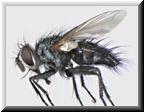Reared specimens examined. None.
There are six species of Blondelia in the Nearctic region (Wood 1985), of which three are known from Canada: B. eufitchiae (Townsend), B. hyphantriae (Tothill) and B. polita (Townsend) (CNC records). No key to the Nearctic species is available.
Wylie (1979) records a single specimen of Blondelia sp. from a bertha armyworm larva collected near Winnipeg, Manitoba in 1976. No other records of Blondelia from this host exist suggesting that such parasitism is extremely rare. The reared specimen could not be located to determine the species involved. Blondelia nigripes (Fallén) is recorded from Mamestra brassicae in the Palearctic region (Herting 1960, Turnock 1984).
Recognition. All but a few members of the Blondeliini are characterized by prosternum haired, first postsutural supra-alar seta smaller than first postsutural dorsocentral seta, bend of vein M forming an obtuse angle, and subapical scutellar setae divergent (Wood 1985). Blondelia species can be distinguished from other blondeliines by bare eyes, middorsal depression on abdominal syntergite 1+2 reaching hind margin of syntergite, parafacial bare, mid tibia with at least 3 well developed anterodorsal setae, and female with recurved piercing ovipositor (modified abdominal sternite 7). See Wood (1985) for a more complete diagnosis of Blondelia.
In addition to the characters given in the key, Blondelia species differ from Exorista larvarum and E. mella (but not from all Exorista species) by the presence of median discal setae on abdominal terga 3 and 4.
Biology. Females of Blondelia and a few related genera are equipped with a piercing ovipositor which is used to inject an incubated egg directly into the body of a host. Hosts are lepidopterous larvae belonging to the families Arctiidae, Geometridae, Olethreutidae, Noctuidae, Notodontidae, Pyralidae and Tortricidae (Arnaud 1978).


